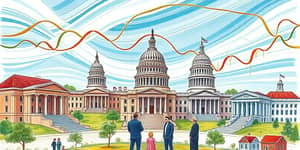
As economic pressures mount, public schools across America are taking bold steps to equip students with the tools they need to navigate an increasingly complex financial landscape.
Today, financial insecurity is widespread in the U.S. A staggering 65% of Americans live paycheck to paycheck, and less than half could cover a $1,000 emergency from savings. Alarmingly, 28% have no savings for the future, while 39% are not contributing to retirement funds.
Financial stress is not confined to adults. Young people face mounting uncertainty as they prepare for college, careers, and independence. Nationwide, 56% of adults report feeling financially anxious, and younger Americans (ages 18–34) experience even higher levels at 69%. This anxiety underscores the essential role schools play in fostering long-term financial resilience.
Over the past five years, momentum has surged. Twenty-seven states have enacted financial literacy requirements for high school graduation, with 16 demanding a stand-alone personal finance course. In total, 46 states have embedded personal finance into K–12 standards, but the depth and rigor of these programs vary widely.
Despite broad legislative support, a 2021 national report card graded 35 states a C, D, or F for their high school financial literacy efforts. This disparity highlights the need for consistent standards and high-quality implementation.
To clarify the national landscape, consider the breakdown of state requirements:
These figures show clear progress, but also room for growth as schools work to translate policy into practice.
Modern financial literacy curricula address a broad spectrum of money skills, empowering students with actionable knowledge. Core subjects include:
Several districts are leading the way with hands-on learning experiences that bring abstract concepts to life. In Maryland, Frederick County Public Schools requires a half-credit financial literacy course, offering 13 specialized classes and engaging over 3,500 students annually in a dynamic Budget Challenge.
Across town, college campuses host Financial Reality Fairs, where students rotate through interactive stations simulating rent payments, loan repayments, and grocery shopping on a constrained budget. These immersive events help young people internalize trade-offs and develop practical money management skills.
Similarly, Junior Achievement’s Advanced Finance Park and the Financial Fitness for Life curriculum use simulation software, role-play, and peer collaboration to foster confidence and competence. Evaluations of these programs reveal tangible benefits: students demonstrate higher saving rates, improved budgeting habits, and a sharper understanding of credit.
Despite promising models, obstacles persist. Variability in educator training, resource allocation, and community support can create uneven outcomes. Moreover, students’ access to quality programs often correlates with local funding levels, risking deeper socioeconomic divides.
Yet, these challenges also present opportunities for collaboration. Schools are increasingly partnering with external organizations—local banks, nonprofit groups, and financial planning firms—to bolster curriculum quality and provide real-world insights.
Assessment is critical. The National Financial Educators Council found that 52% of students aged 15–18 failed to achieve a passing score on a basic financial literacy exam, despite coursework. This gap highlights the difference between course completion and true competence.
International studies echo these findings: countries that mandate financial education, like Portugal, see consistent improvements in both knowledge and real-world behaviors. Research shows that students exposed to quality financial literacy programs have lower rates of problematic debt as young adults and are more likely to save and invest wisely.
As financial products and digital marketplaces evolve, so must education. Emerging content areas—digital finance and cryptocurrency basics, understanding inflation, and navigating online banking—are finding their way into updated standards.
To maximize impact, schools should focus on:
By weaving financial literacy into the fabric of public education, we can empower the next generation to make informed decisions, build secure futures, and contribute to a healthier economy.
Financial literacy is more than a subject—it’s a vital life skill. As programs expand and evolve, public schools have the opportunity to mold financially savvy citizens ready to face life’s challenges with confidence and clarity.
References













